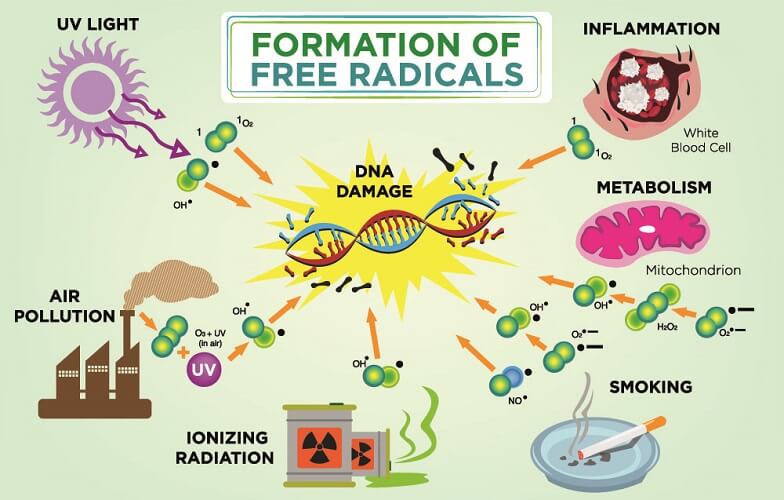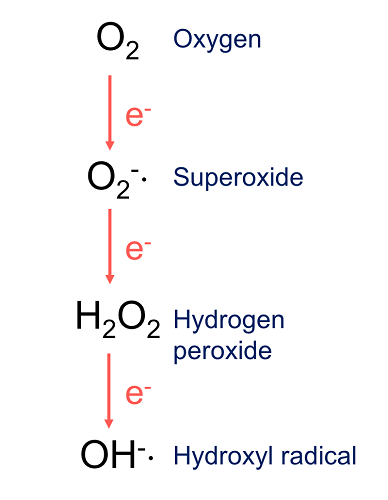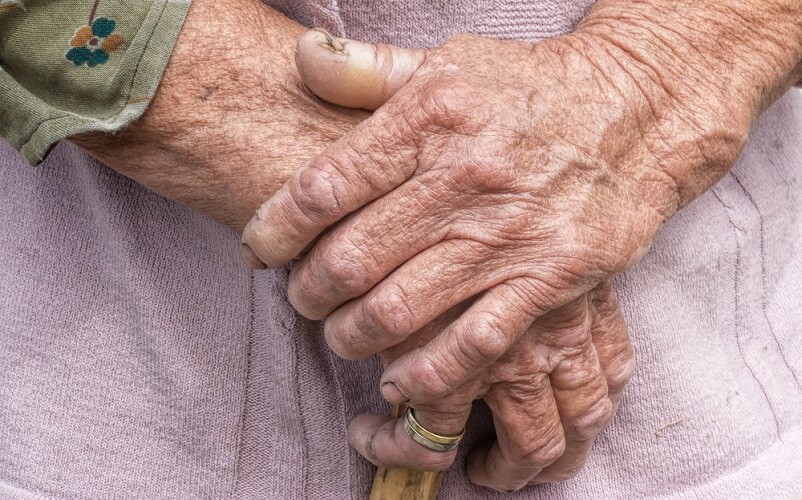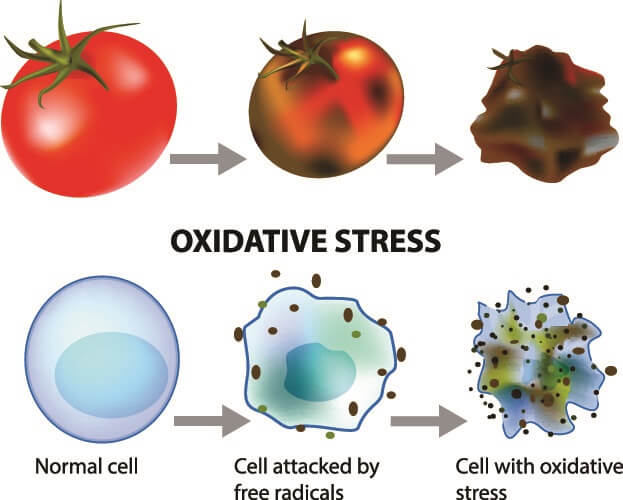Definition
Oxidative stress describes an imbalance between the production and accumulation of by-products of oxygen metabolism called reactive oxygen species (ROS). ROS molecules are (free) radicals that contain oxygen and react with other molecules inside a cell or tissue. In balanced quantities, they are essential for our health. In high quantities, they can be damaging. Certain environmental aspects such as UV light, radiation, and pollution also affect ROS accumulation through the production of free radicals.
What is Oxidative Stress?
To know what oxidative stress is, you first need to understand a range of terms.
Free Radicals
Radicals (free radicals) are molecules with at least one unpaired valance electron. Most atoms and molecules are constantly attempting to fulfill the octet rule. This rule – although it has its exceptions – says that atoms will always try to fill their valance ring (outer ring of electrons) with eight electrons. This increases their stability.

Examples of free radicals are nitric oxide and nitrogen dioxide. Both have free (unpaired) electrons that attempt to join with other molecules to make them more stable. In laughing gas form (nitrous dioxide), nitronium cations, and nitrite anions, there are no unpaired electrons – these mixtures of nitrogen and oxygen are, therefore, not radicals.
Radicals work in two ways. When they attempt to fill their valance shell with an electron from another atom, they are oxidants. When radicals give an outer electron to another atom, they are reducing agents. Not all oxidants and reducing agents are free radicals.
Free radicals are short-lived as they quickly bind to other atoms to fulfill the octet rule.

All reactive oxygen species are radicals, but not all radicals are ROS. Only radicals that contain oxygen can be ROS. As most biological systems require oxygen and nearly all human cells are aerobic, it is safe to assume that the human body produces more ROS than non-oxygen radicals. Ordinary oxygen (O2) does not easily react with other molecules; it is reactive, however, in its ROS forms.
Reactive Oxygen Species
Reactive oxygen species are primarily produced inside the mitochondria of cells. They are also manufactured in the plasma membrane, cytosol, peroxisomes, and endoplasmic reticulum. Superoxide ions (O2•–), for example, are required for many cellular reactions. Superoxide has two main sources – mitochondrial respiration and NADPH oxidase. NADPH oxidase is an essential part of our immune system. When triggered, it produces superoxide that kills bacteria.

The most common reactive oxygen species in the body are superoxide radicals (O2•–), hydrogen peroxide (H2O2), hydroxyl radicals (•OH), and singlet oxygen (1O2). These ROS are necessary for biological processes that include:
- Protein phosphorylation (protein function regulation)
- Transcription factor activation
- Apoptosis (programmed cell death)
- Immunity
- Cell differentiation
This means that ROS production is necessary for good health. It is ROS accumulation that leads to countless disorders and diseases. When reactive oxygen species accumulate, the result is oxidative stress.

Reactive Nitrogen Species
Reactive nitrogen species (RNS) are mainly represented by the free radical nitric oxide (NO•). NO• is the result of L-arginine (an amino acid) metabolism. NO• produced in nerve cells helps toward neuron communication; in macrophages and smooth muscle cells, nitric oxide contributes to immunity; NO• also relaxes blood vessels and maintains normal blood pressure.

Oxidation and Reduction
As already mentioned, free radicals act as oxidants when they use another atom’s electron to fill their valance shell. In an oxidation reaction, made possible through the presence of radicals, two opposite reactions happen at the same time.
When a free radical takes an electron from another molecule, it behaves as an oxidant; the other molecule (that gives up an electron) is the reducing agent. The opposite applies for free radicals that give up an electron to another atom or molecule – this time the free radical is the reducing agent and the other structure is the oxidant.

Oxidation has three definitions – loss of electrons, addition of oxygen, or subtraction of hydrogen.
Reduction has opposite definitions – gain of electrons, subtraction of oxygen, or addition of hydrogen.
As you need two atoms or molecules for a reaction to take place, oxidation and reduction must occur at the same time. We, therefore, refer to these two processes as redox reactions.
This means that all free radical reactions in the human body are redox reactions. These redox reactions occur in all of our metabolic processes (supplied by the energy produced through mitochondrial respiration) and within our immune system (NADPH oxidase).
Antioxidants and Pro-Oxidants
Antioxidants stop the oxidation process. As an oxidation reaction also requires a reduction reaction, antioxidants should perhaps be better referred to as antiredoxidants.

Oxidation and reduction reactions form radicals throughout the range of intracellular processes; anything that slows or halts these reactions leads to less free radical production. However, free radicals are essential for human life and it is impossible to avoid them without dying.
Antioxidants are only recommended in cases of oxidative stress. As external sources of free radicals are readily absorbed via our respiratory system, skin, and digestive system, and as we produce more free radicals as we age, it is unlikely that we can overdose on anti-oxidative stress supplements. Even so, we do not yet understand every reaction caused by every antioxidant.
It is also highly unlikely we are unable to produce enough free radicals at certain stages of life.

Examples of antioxidants are vitamin C, glutathione, catalase, superoxide dismutase, ubiquinone, lipoic acid, uric acid, carotenes, vitamin E, flavonoids, and coenzyme Q. Even exercise is an antioxidant.
A pro-oxidant encourages oxidant reactions and either increases ROS production or blocks the actions of antioxidants. One important blood test is homocysteine. High levels of this pro-oxidant may predict the presence of oxidative stress. Strangely, vitamin C also has been known to produce pro-oxidant effects.

Oxidative Stress Causes
Oxidative stress causes number in their thousands and research is still ongoing. However, all of these causes are the result of ROS production exceeding anti-oxidant defenses. Oxidate stress is not simply the production of free radicals.
When the cause of stress is reactive nitrogen species, this phenomenon is known as nitrosative stress.
At low concentrations, ROS and RNS are part of regulatory reactions in several important cellular processes. However, in moderate to high concentrations, they can inhibit these processes rather than help them.

It is impossible to point the finger at a single cause of oxidative stress. It is, however, possible to find the underlying mechanism. For example, a systemic inflammatory state, such as found in the obese and diabetics, produces excess superoxide and nitric oxide. These react together (fulfilling the octet rule) and form peroxynitrite anion (ONOO–). This very strong oxidant fragments DNA and damages the lipids of cell membranes (lipid peroxidation).
Alternatively, smoking forms two types of free radicals that fragment DNA, turn thiols into disulfides, and encourage lipid peroxidation.
The top causes of oxidative stress are:
- Environmental toxins (air pollution, contact with chemicals)
- Disruption to circadian rhythm
- Chronic inflammation
- Infection
- Smoking
- Processed foods
- Drugs and medication
- Sedentary lifestyle
- Psychological disorders
- Aging
- Hormone imbalances
Oxidative Stress Symptoms

Oxidative stress symptoms depend on the part(s) of the body that are affected. As oxidative stress is the result of systemic free radical accumulation or free radical accumulation in certain tissue or cell types, most diseases and disorders are likely associated with oxidative stress.
The more we learn about oxidative stress, the more we realize how central it is to all types of disease. As yet, we do not have the knowledge, the data, or the equipment to calculate daily free radical production rates or requirements. Perhaps the treatment of future disease will involve direct responses to early oxidative stress markers.

At present, we use known oxidative stress markers to look at risk. For example, excess reactive oxygen species are closely linked to cardiovascular disease. Using biomarker results – a biomarker, in this case, is a molecule that has been modified via ROS redox reactions – we can indicate how likely a person is to develop this disease. It is also possible to use this marker to monitor existing cardiovascular disease. Cardiovascular disease markers such as nitrotyrosine and myeloperoxidase (MPO) are being studied as a form of predictive (and preventive) medicine.
Oxidative Stress Supplements
Oxidative stress supplements may improve health levels, especially in cases of chronic illness, older age, and living in high pollution areas. Even so, research shows the benefits are not nearly as high as many supplement manufacturers suggest.

Raw fruits and vegetables offer different antioxidant effects. For example, grapefruit and garlic inhibit P450 cytochrome enzymes that oxidize steroids and fatty acids. Green tea polyphenols seem to inhibit cell proliferation; flavonoids balance hormonal disorders.
Better cardiovascular and neurological health is seen in populations that regularly consume fresh fruit and vegetables. Local produce is usually of higher quality than fresh foods that have been transported over long distances and/or stored. Furthermore, non-organic food production often includes chemicals that can reverse their antioxidant effects.
Eating the right number of calories per day decreases oxidative stress. Overeating leads to weight gain and subsequent inflammatory reactions. Calorific restriction has been shown to reduce mitochondrial ROS production and associated oxidative damage. It is important to note that any restrictive diet needs to include a broad range of unprocessed foods to ensure sufficient macro- and micronutrients.

The best ways to reduce oxidative stress include removing processed foods from the diet and – where possible – integrating organic sources, taking regular exercise, living in low-pollution areas, avoiding potentially-harmful chemicals (cleaning products, smoking), and ensuring sufficient sleep and rest times. Psychological health is just as important if you want to reduce the effects of oxidative stress.
While we cannot reverse aging, keeping the mind positive and the body healthy is the best way to reduce the effects of oxidative stress.

